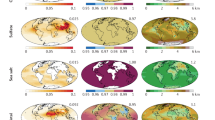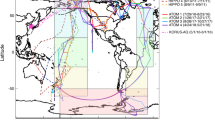Abstract
ATMOSPHERIC aerosols can affect climate by scattering and absorbing solar radiation1–3. Most recent studies of such effects have focused largely on anthropogenic sulphate aerosols, which are believed to exert a substantial cooling influence2. Mineral dust aerosols have been largely ignored, because it was thought that their scattering efficiency and concentrations were too low to have a substantial effect on climate. Here we report measurements of the light-scattering properties of North African dust delivered to Barbados by the North Atlantic trade winds. Although the mass scattering efficiency of the dust is only about a quarter of that of non-seasalt sulphate over the North Atlantic5, the annual-mean dust concentration in Barbados trade-wind air is 16 times that of non-seasalt sulphate6. The net scattering by mineral dust is therefore about four times that by non-seasalt sulphate aerosols. African mineral dust should therefore be the dominant light-scattering aerosol throughout the tropical and subtropical North Atlantic region. Our observations suggest that mineral dust could be an important climate-forcing agent over this ocean region and in other regions where dust concentrations are high7,8.
This is a preview of subscription content, access via your institution
Access options
Subscribe to this journal
Receive 51 print issues and online access
$199.00 per year
only $3.90 per issue
Buy this article
- Purchase on Springer Link
- Instant access to full article PDF
Prices may be subject to local taxes which are calculated during checkout
Similar content being viewed by others
References
Shaw, G. E. Atmos. Envir. 21, 985–986 (1987).
Charlson, R. J., Langner, J., Rodhe, H., Leovy, C. B. & Warren, S. G. Tellus 43AB, 152–163 (1991).
Hobbs, P. V. in Aerosol-Cloud-Climate Interactions (ed. Hobbs, P. V.) 33–73 (Academic, San Diego, 1993).
Charlson, R. et al. Science 255, 423–430 (1992).
Hegg, D. A., Ferek, R. J. & Hobbs, P. V. J. geophys. Res. 99, 25951–25954 (1994).
Savoie, D. L. et al. J. geophys. Res. 97, 11575–11589 (1992).
Duce, R. A. et al. Globl biogeochem. Cycles 5, 193–259 (1991).
Prospero, J. M. in The Oceanic Lithosphere (ed. Emiliani, C.) 801–974 (Wiley Interscience, New York, 1981).
Charlson, R. J. & Wigley, T. M. L. Scient. Am. 270, 48–57 (1994).
Prospero, J. M. & Nees, R. T. Nature 320, 735–738 (1986).
Prospero, J. M., Savoie, D. L., Arimoto, R. & Huang, F. (abstr.) Eos 74(43), 146 (1993).
Ott, S.-T., Ott, A., Martin, D. W. & Young, J. A. Mon. Weath. Rev. 119, 1832–1850 (1991).
Prospero, J. M. & Carlson, T. N. J. geophys. Res. 77, 5255–5265 (1972).
Carlson, T. N. & Prospero, J. M. J. appl. Met. 11, 283–297 (1972).
Ruby, M. G. & Waggoner, A. P. Envir. Sci. Technol. 15, 109–113 (1981).
Anderson, T. L., Charlson, R. J., White, W. H. & McMurry, P. H. J. geophys. Res. 99, 25947–25949 (1994).
Quinn, P. K., Marshall, S. F., Bates, T. S., Covert, D. S. & Kapustin, V. N. J. geophys. Res. 100, 8977–8991 (1995).
Savoie, D. L. & Prospero, J. M. Geophys. Res. Lett. 9, 1207–1210 (1982).
Lepple, F. K. & Brine, C. J. J. geophys. Res. 81, 1141–1147 (1976).
White, W. H., Macias, E. S., Ninenger, R. C. & Schorran, D. Atmos. Envir. 28, 909–921 (1994).
Talbot, R. W. et al. J. geophys. Res. 91, 5173–5182 (1986).
Duce, R. A. in Dahlem Workshop on Aerosol Forcing of Climate (eds Charlson, R. J. & Heintzenberg, J.) 43–72, (Wiley, Chichester, 1995).
Andreae, M. O. in Future Climates of the World (ed. Henderson-Sellers, A.) 341–392 (Elsevier, Amsterdam, 1995).
Tegen, I., Lacis, A. A. & Fung, I. Nature 380, 419–422 (1996).
Glantz, M. H. in Drought Follows the Plow (ed. Glantz, M. H.) 33–43 (Cambrdige Univ. Press, 1994).
Tegen, I. & Fung, I. J. geophys. Res. 100, 18707–18726 (1995).
Lacis, A. A. & Mishchenko, M. I. in Dahlem Workshop on Aerosol Forcing of Climate (eds Charlson, R. J. & Heintzenberg, J.) 11–42 (Wiley, Chichester, 1995).
Pszenny, A., Fischer, C., Mendez, A. & Zetwo, M. Atmos. Envir. 27A, 282–284 (1993).
Savoie, D. L., Prospero, J. M. & Saltzman, E. S. J. geophys. Res. 94, 5069–5080 (1989).
Author information
Authors and Affiliations
Rights and permissions
About this article
Cite this article
Li, X., Maring, H., Savoie, D. et al. Dominance of mineral dust in aerosol light-scattering in the North Atlantic trade winds. Nature 380, 416–419 (1996). https://doi.org/10.1038/380416a0
Received:
Accepted:
Issue Date:
DOI: https://doi.org/10.1038/380416a0
This article is cited by
-
Natural and anthropogenic contributions to the hurricane drought of the 1970s–1980s
Nature Communications (2022)
-
Dust induced radiative perturbations during an episode of long-range dust transport over Delhi, India: a high-resolution regional NWP model study
Meteorology and Atmospheric Physics (2021)
-
Solar radiation attenuation by aerosol: application to solar farms
Air Quality, Atmosphere & Health (2020)
-
Using Remote Sensing and GIS Techniques in Monitoring and Mitigation of Geohazards in Najran Region, Saudi Arabia
Geotechnical and Geological Engineering (2019)
-
Spatial and temporal trends of dust storms across desert regions of Iran
Natural Hazards (2018)
Comments
By submitting a comment you agree to abide by our Terms and Community Guidelines. If you find something abusive or that does not comply with our terms or guidelines please flag it as inappropriate.



